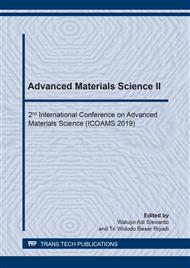[1]
S. Nishida. Failure Analysis in Engineering Application, Butterworth-Heinemann, 1992: 1-220. https://doi.org/10.1016/C2013-0-06527-9.
Google Scholar
[2]
Mohamed Iben Houri, Yves Nadot, Raouf Fathallah, et al. Influence of casting defect and SDAS on the multiaxial fatigue behaviour of A356-T6 alloy including mean stress effect. International Journal of Fatigue, 2015, 80: 90-102. https://doi.org/10.1016/j.ijfatigue.2015.05.012.
DOI: 10.1016/j.ijfatigue.2015.05.012
Google Scholar
[3]
Choong do Lee. Effect of T6 heat treatment on the defect susceptibility of fatigue properties to microporosity variations in a low-pressure die-cast A356 alloy. Materials Science and Engineering: A, 2013, 559: 496-505. https://doi.org/10.1016/j.msea.2012.08.131.
DOI: 10.1016/j.msea.2012.08.131
Google Scholar
[4]
Shun-cheng Wang, Nan Zhou, Wen-jun Qi, et al. Microstructure and mechanical properties of A356 aluminum alloy wheels prepared by thixo-forging combined with a low superheat casting process. Transactions of Nonferrous Metals Society of China, 2014, 24(7): 2214-2219. https://doi.org/10.1016/S1003-6326(14)63335-5.
DOI: 10.1016/s1003-6326(14)63335-5
Google Scholar
[5]
E. Aguirre-De la Torre, U. Afeltra, C.D. Gómez-Esparza, et al. Grain Refiner Effect on the Microstructure and Mechanical Properties of the A356 Automotive Wheels. Journal of Materials Engineering and Performance, 2014, 23(2): 581–58. https://doi.org/10.1007/s11665-013-0596-x.
DOI: 10.1007/s11665-013-0596-x
Google Scholar
[6]
Tae Il So, Hwa Chul Jung, Choong Do Lee, et al. Effects of T6-treatment on the defect susceptibility of tensile strength to microporosity variation in low pressure die-cast A356 alloy. Metals and Materials International, 2015, 21(5): 842-849. https://doi.org/10.1007/s12540-015-5247-3.
DOI: 10.1007/s12540-015-5247-3
Google Scholar
[7]
Jufu Jiang, Ying Wang, Gang Chen, et al. Comparison of mechanical properties and microstructure of AZ91D alloy motorcycle wheels formed by die casting and double control forming. Materials & Design, 2015, 40: 541-549. https://doi.org/10.1016/j.matdes.2012.04.029.
DOI: 10.1016/j.matdes.2012.04.029
Google Scholar
[8]
Jufu Jiang, Yuansheng Cheng, Zhiming Du, et al. Effect of Pressure on Microstructure and Mechanical Properties of AM60B Alloy Used for Motorcycle Wheels Formed by Double Control Forming. Journal of Materials Science & Technology, 2013, 29(5): 439-445. https://doi.org/10.1016/j.jmst.2013.02.009.
DOI: 10.1016/j.jmst.2013.02.009
Google Scholar
[9]
D.M. Maijer, Y.X. Gao, P.D. Lee, et al. A through-process model of an A356 brake caliper for fatigue life prediction. Metallurgical and Materials Transactions A. 2004, 35(10): 3275–3288. https://doi.org/10.1007/s11661-004-0070-3.
DOI: 10.1007/s11661-004-0070-3
Google Scholar
[10]
Lorella Ceschini, Alessandro Morri, Andrea Morri. Effects of the Delay Between Quenching and Aging on Hardness and Tensile Properties of A356 Aluminum Alloy. Journal of Materials Engineering and Performance. 2013, 22(1): 200–205. https://doi.org/10.1007/s11665-012-0208-1.
DOI: 10.1007/s11665-012-0208-1
Google Scholar
[11]
Mohammad Azadi, Mehdi Mokhtari Shirazabad. Heat treatment effect on thermo-mechanical fatigue and low cycle fatigue behaviors of A356.0 aluminum alloy. Materials & Design, 2013, 45: 279-285. https://doi.org/10.1016/j.matdes.2012.08.066.
DOI: 10.1016/j.matdes.2012.08.066
Google Scholar
[12]
Hasan Akhyar, Priyo Tri Iswanto, Viktor Malau. Non Treatment, T4 and T6 on Tensile Strength of Al-5.9Cu-1.9Mg Alloy Investigated by Variation of Casting Temperature. Materials Science Forum, 2018, 929: 56-62.
DOI: 10.4028/www.scientific.net/msf.929.56
Google Scholar
[13]
Libin Niu, Mirabbos Hojamberdiev, Yunhua Xu. Preparation of in situ-formed WC/Fe composite on gray cast iron substrate by a centrifugal casting process. Journal of Materials Processing Technology, 2010, 14(1): 1986-1990. https://doi.org/10.1016/j.jmatprotec. 2010.07.013.
DOI: 10.1016/j.jmatprotec.2010.07.013
Google Scholar
[14]
Xiaoyu Huang, Changming Liu, Xunjia Lv, et al. Aluminum alloy pistons reinforced with SiC fabricated by centrifugal casting. Journal of Materials Processing Technology, 2011, 211: 1540-1546. https://doi.org/10.1016/j.jmatprotec.2011.04.006.
DOI: 10.1016/j.jmatprotec.2011.04.006
Google Scholar
[15]
Kum-Hee Seo, Je-Beom Jeon, Ji-Won Youn, et al. Recycling of Al–Si die casting scraps for solar Si feedstock. Journal of Crystal Growth, 2016, 442: 1-7. https://doi.org/10.1016/j.jcrysgro.2016.02.022.
DOI: 10.1016/j.jcrysgro.2016.02.022
Google Scholar
[16]
G.Chirita, D.Soares, F.S. Silva. Advantages of the centrifugal casting technique for the production of structural components with Al–Si alloys. Materials & Design, 2008, 29(1): 20-27. https://doi.org/10.1016/j.matdes.2006.12.011.
DOI: 10.1016/j.matdes.2006.12.011
Google Scholar
[17]
Zhiwei Liu, Xiaoming Wang, Qingyou Hana, et al. Effects of the addition of Ti powders on the microstructure and mechanical properties of A356 alloy. Powder Technology, 2014, 253: 751-756. https://doi.org/10.1016/j.powtec.2013.12.052.
DOI: 10.1016/j.powtec.2013.12.052
Google Scholar
[18]
Priyo Tri Iswanto, Hasan Akhyar, Faris Fadil Utomo. Effect of Shot Peening at Different Almen Intensities on Fatigue Behavior of AISI 304. Metalurgija, 2018, 57(4): 295-298.
Google Scholar
[19]
M.J. Roy, D.M. Maijer. Response of A356 to warm rotary forming and subsequent T6 heat treatment. Materials Science and Engineering: A, 2014, 611: 223-233. https://doi.org/10.1016/j.msea.2014.05.088.
DOI: 10.1016/j.msea.2014.05.088
Google Scholar
[20]
Tongmin Wang, Yufei Zhao, Zongning Chen, et al. Combining effects of TiB2 and La on the aging behavior of A356 alloy. Materials Science and Engineering: A, 2015, 644: 425-430. https://doi.org/10.1016/j.msea.2015.07.076.
DOI: 10.1016/j.msea.2015.07.076
Google Scholar
[21]
Hasan Akhyar, Viktor Malau, Suyitno, et al. Hot tearing susceptibility of aluminum alloys using CRCM-Horizontal mold. Results in Physics, 2017, 7: 1030-1039. http://dx.doi.org/10.1016/j.rinp.2017.02.041.
DOI: 10.1016/j.rinp.2017.02.041
Google Scholar
[22]
Viktor Malau, Akhyar, Priyo Tri Iswanto. Modification of Constrained Rod Casting Mold for New Hot Tearing Measurement. Archives of Metallurgy and Materials, 2018, 63(3), 1201-1208.
Google Scholar
[23]
G. Golański, A. Zyska, K. Werner, et al. Analysis of the failure causes in an element made of AlSi11Cu2(Fe) alloy. Archives of Foundry Engineering, 2011, 11(2): 29-34.
Google Scholar
[24]
R. Wieszałaa, J. Piątkowski. Fatigue Resistance of A390.0 Alloy Modified with Phosphorus. Archives of Foundry Engineering, 2015, 15(3): 99-103.
Google Scholar
[25]
Priyo Tri Iswanto, Akhyar, Erick Umbu K. Maliwemu, Fatigue Crack Growth Rate of Motorcycle Wheel Fabricated by Centrifugal Casting. Metalurgija, 2019, 58(1-2): 51-54.
Google Scholar
[26]
Jaap Schijve. The application of small overloads for fractography of small fatigue cracks initiated under constant-amplitude loading. International Journal of Fatigue, 2015, 70: 63–72. http://dx.doi.org/10.1016/j.ijfatigue.2014.09.001.
DOI: 10.1016/j.ijfatigue.2014.09.001
Google Scholar


